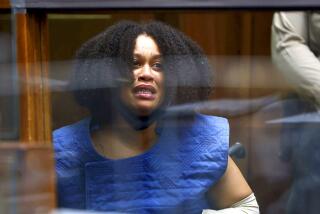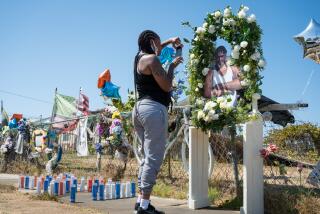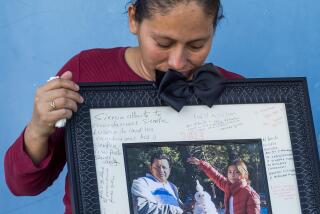For Students, a Sobering Lesson on Drunk Driving
Some 500 high school seniors, rustling and restless after four hours in their seats, snapped into silence when a picture was displayed of a mangled wreck in which three people died at the hands of a drunk driver.
“Everyone gets the same consequence for the same offense,” Los Angeles County Deputy Dist. Atty. Michele Hanisee told the Claremont High School students. “Good attorneys aren’t going to get you off.”
It was another sobering moment for the senior class Wednesday, the conclusion of an anti-drinking-and-driving program that began with the real criminal trial of a drunk driver.
The idea is to show the real consequences of irresponsibility, said Claremont Police Capt. Paul Cooper. “We’re giving them information and actual life experience,” he said. “It’s a snapshot opportunity we wanted to expose them to and give them that experience.”
Teenagers don’t always realize what their actions will lead to.
“One hopes that maybe you could get some of these kids to actually pay attention,” Hanisee said. “I’m hoping they will realize the many, many consequences of driving under the influence.”
Of the 3,643 fatal vehicle crashes in California in 2002, 1,452 of them were alcohol-related, according to the National Highway Traffic Safety Administration. In 2001, the California Highway Patrol reported that 173 drivers ages 15 to 20 had been drinking when a fatality occurred.
The number of intoxicated teen drivers involved in fatal crashes dropped 7% from 1992 to 2002, according to the NHTSA. Presiding Los Angeles Superior Court Judge Daniel Buckley was enthusiastic about the program.
“I think when young people see directly the consequences of their actions,” he said, “then they better understand why they should not do it ... I am confident we reached someone today.”
Buckley recognized that students might have grappled a bit with the length and tediousness of the trial, but said he was impressed by their questions.
On trial was Adrian Gomez, 23, who crashed into a guardrail on the Grand Avenue offramp of the Foothill Freeway in Glendora about 2:30 a.m. Dec. 26. He didn’t injure anyone, nor was he injured.
Gomez was charged with two counts of driving under the influence, and a special allegation of having an extremely high blood-alcohol level.
Much of the morning ran as it would have in a regular courtroom.
When Leo Summerhays, a chemist with the Los Angeles County Sheriff’s Department, took the stand and explained that Gomez had to have consumed 13 glasses of wine in one sitting -- “what’s commonly known on the street as chug-a-lug,” he said -- the students laughed.
Buckley, acting as judge and jury, found Gomez guilty on all counts. As part of the program, 12 students were chosen at random to render their own verdict.
They deliberated for 15 minutes in a small, sunlit kitchen in the back of the auditorium. They tried to give Gomez the benefit of the doubt, but quickly established his guilt. School officials asked that their last names not be used.
“I do think he’s guilty,” said a student named Chelsea, “but it is possible that he fell asleep. But if his blood level was 0.25% ... “
“I think it is a possibility that he fell asleep at the wheel,” said Isaiah, “but you do have to look at the facts and the blood test.”
A student named Kylie pointed out that the defense attorney, T. Douglas Allen, ignored some of the evidence presented by the prosecution.
“That was weird,” she said. “Like he didn’t have any evidence to support” his claims.
Afterward, a senior named Michael, who was on the advisory jury and wants to be a lawyer, said he was thrilled to be able to participate. “I thought that was really cool to see how it works,” he said.
Prosecutor Hanisee said Gomez was doing the community a favor by agreeing to undergo a criminal trial at the school, said to be the first ever in Los Angeles County outside of a courthouse.
“Whether he intends to or not, he is doing a public service by having a trial in this forum,” Hanisee said.
Gomez did not speak. Buckley sentenced him to probation, community service and an alcohol treatment program. Buckley gave Gomez credit for participating in the anti-drinking-and-driving program, which was sponsored through a state grant from the Office of Traffic Safety and organized by the Superior Court and Claremont police.
“You always hear about all the consequences, but you never really see it,” a student named Billy said.
Billy said he has intervened when his friends have tried to drive while drunk. “But you can’t keep track of everybody at a party,” he said. “They impress it upon you your whole life, but kids drink and drive anyway.... Hey, every little bit helps.”
More to Read
Sign up for Essential California
The most important California stories and recommendations in your inbox every morning.
You may occasionally receive promotional content from the Los Angeles Times.










